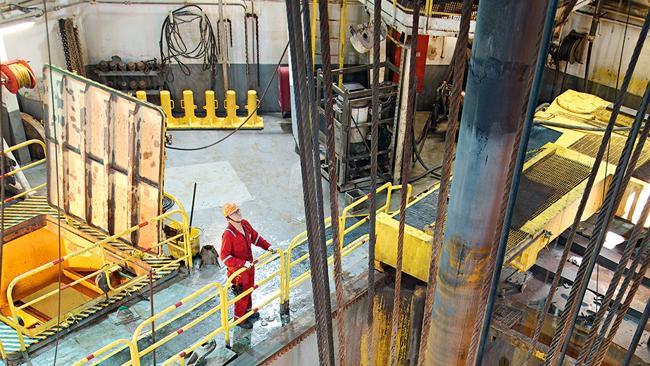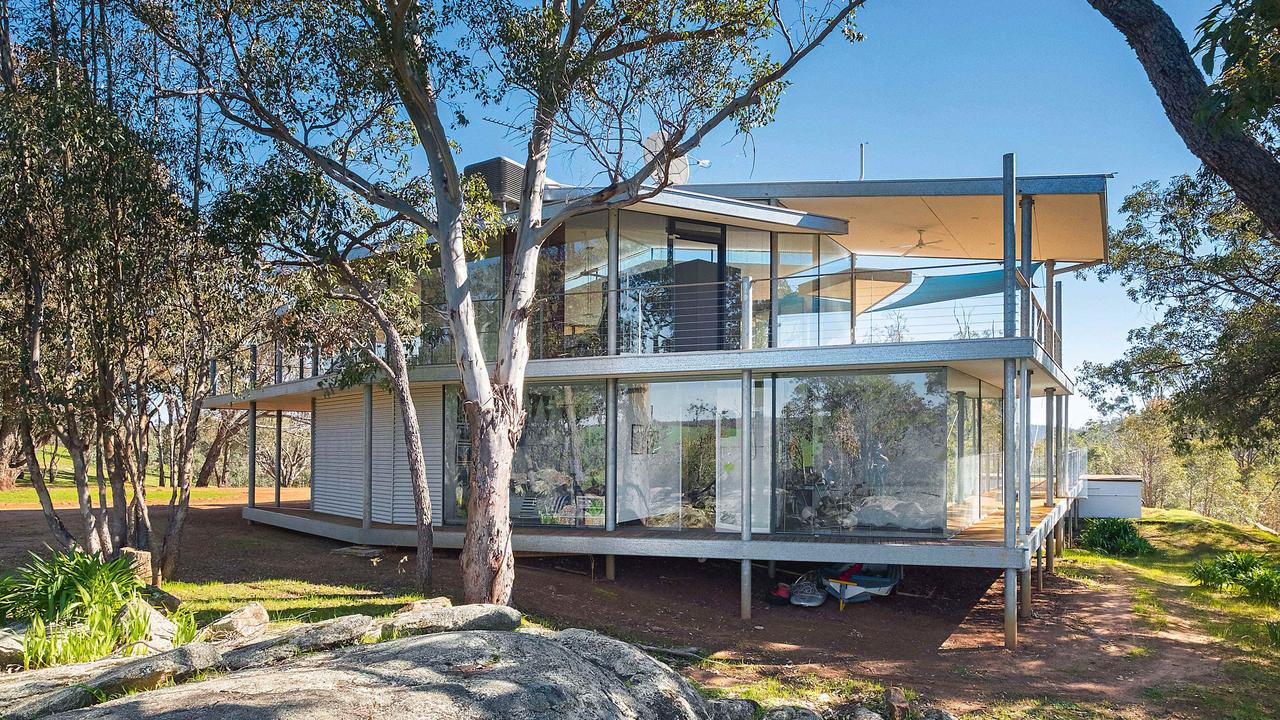Hard daily grind: what it’s like to work on an offshore rig
FOR 130 workers toiling on a rig off the northwest coast, the rewards outweigh the risks — and the daily hard grind.

THE Sikorsky chopper looked so huge when we boarded it back in Broome. Now, out here in this remote part of the Indian Ocean, 500km off Western Australia’s northwest coast, the drilling platform we are about to land on looks impossibly small.
For a first-timer like me the minimal margin for error is disconcerting, but for most of the 16 passengers this is a routine commute. Welcome aboard the Jack Bates, one of the dozen or so drilling platforms working in Australian waters in the hunt for the next big oil and gas discovery.
It may look like a dot in the ocean from the air but once on board, everything about the 113m by 78m rig is big: big tools, big risks and big salaries. Spencer Zorich, from Adelaide, has one of the most physically challenging jobs on the rig and he emerges from his shift encrusted in mud and dirt from handling the drill bits and drill casing. “Not everyone can do this, get on that plane, get on that chopper and then work, and be away from your family,” the 35-year-old says. “You’ve got to be mentally strong to keep going.”
Exploration work is expensive. Hiring a rig costs around $130 million for three months’ work. There’s a good chance that the well the Jack Bates is drilling at the time of our visit — the Lasseter well for Adelaide-based company Santos — will cost significantly more than that due to the remoteness and geological complexity of the Browse Basin. This well’s target sits more than 5km beneath the seabed, and Santos will know by the end of July whether it has hit pay dirt.
The 140,000 sq km Browse Basin — more than twice the area of Tasmania — is home to numerous massive gas discoveries dating back more than 40 years, but is still only on the cusp of being developed. Japanese company Inpex is leading the construction of the $US34 billion Ichthys liquefied natural gas (LNG) project, which will exploit gas fields just east of the Lasseter well. Royal Dutch Shell is building the world’s first floating LNG vessel — the largest ship in history — for the nearby Prelude gas field, while Woodside Petroleum and its partners plan to spend an estimated $35 billion developing their Browse gas fields to the east.
While Lasseter is considered a good chance of yielding a discovery, the reality is that most exploration wells fail. A successful well, however, can reap billions of dollars’ worth of gas.
Life out here is a world that not many get to see. It is completely removed from the real one back home and the work is relentless: 12-hour shifts, day in and day out, for 28 days straight until the chopper returns to ferry workers back to the mainland for four weeks off. Looking out from the rig, there is nothing but sea and sky in every direction. Yet the vista is compelling and evolves over the course of the day as shifting light and weather and varying swells make their mark on the pattern of the waves. At sunset, the sky takes on vivid purples and pinks.
Not that there is much time to enjoy the view; life here is consumed by work. Space is tight, and the only outside area that can be accessed without the requirement for head-to-toe protective equipment is the helipad. Those workers still with energy to burn at the end of their shift can run (very small) laps of the helipad, or visit the gym that has been squeezed into an unused corner of the rig. As far as leisure goes, there’s a recreation room with a ping pong table and a PlayStation. The rig is alcohol-free.
Two workers, one from the day shift, one from the night shift, share a small cabin — narrow, almost prison cell-like rooms that contain little more than a set of bunk beds, some lockers, a basic bathroom and a television. Even while lying in a bunk to sleep, the audible hum of the rig boring its way deep into the earth is a constant reminder that work is never far away.
The rig is a temporary home to a diverse mix of nationalities: there are Australians, Canadians, Scots, Indonesians and Filipinos among the 130 workers, with only a handful of women among them. For all the technological progress made in the industry in recent decades, drilling remains a messy and physical process. The vernacular on board reflects the industry’s blokey origins — among the workers are “roughnecks” and “roustabouts”, and different parts of the rig have earned their own nicknames: there’s the tree house, the monkey board, the moon pool, the dance floor and the Dodge truck. Within the rig, most of the men get about in the same standard-issue coveralls. Adding a slightly cultish feel are the matching Crocs (water-resistant clogs) that workers wear outside the areas where steelcap boots are necessary.
There is an extraordinary amount of technology and science behind the process, but there is still a hint of pride about the amount of sweat and muscle that goes into the drilling of a well. The big pay cheques are a lure: an entry-level, unskilled worker can expect to earn $120,000-$150,000 a year, while a junior roughneck will start on anything between $150,000 and $180,000. A junior professional can command $220,000. But it comes with real obligations and sacrifices.
Overseeing the operations of this particular well is Ian Rice, 58, a senior drilling supervisor for Santos. A carpenter by trade, he’s been in the job for 36 years, working on rigs from the North Sea to Brunei and Northern Africa. “I’ve got to a stage where I don’t hate it here anymore. You get used to doing your time,” he says. “You do your time here, and then your time off is great.” He has adjusted to having two different lives, one on the rig and one at home with his wife and two children, but he has seen plenty of men and families over the years who simply can’t cope. “I’ve missed 50 per cent of the Christmases and the New Years and the birthdays. You do miss those important times,” he says.
As a result he never expected to see his kids follow him into the industry. But in recent months, his eldest son secured a painting job during his university’s Christmas break. For a young single man, the money on offer — coupled with the plentiful meals and daily laundry service on board — are very strong lures.
Chef Mal Gale, 41, started working in restaurants at 14, and spent most nights and every weekend in the kitchen. In comparison, the four weeks on, four weeks off roster on the rig is a bonus. “The money aspect was the calling card, but the biggest thing after having children was actually having time off to spend at home,” Gale says. He concedes the daily repetition on the rig is a struggle, but the trade-off is worth it. “It’s like having six months’ holiday after cramming all the work into six months of the year, and having that much time to do exactly what you want, whether that’s going down south or just taking the kids to school.”
A colleague in the galley, Tanya Holdway, 38, is one of the few women on board. “I’ve been the only chick on the rig sometimes. It doesn’t bother me, I’m one of the boys really,” she says. “Sometimes I do find it’s a bit of a struggle with some of the men. Some of the old guys don’t believe women should be on the rig, and some guys will try it on, but generally it’s fine and professional.”
Like many other workers, the promise of big money was Holdway’s primary motivation. She was struggling to get ahead financially while working in fine dining in Sydney, so headed west. Young and single, she has fallen in to the same bad habit as many others: the weeks of relentless work make it easy to justify a splurge in her time off — she travels frequently to Asia and Melbourne and Sydney, and has all too often found herself heading off to her next hitch no better off financially than she was after her last. “You hear the stories from a lot of guys who say, ‘I’m going to be out in five years’, and then 10 years later they’re still here. I plan on not being one of those people,” she says. “I’ve made a new rule, no more holidays unless it’s cash only. No more credit cards.”
The obsession with safety that this sort of work demands begins months before anyone can set foot on the rig. First is the helicopter underwater escape training, or HUET. It involves strapping individuals into the seats of a mock helicopter cabin which is then dropped into a pool and turned upside down, leaving participants to unharness themselves, push out a window and find their way to the surface. There are divers at the ready to rescue anyone who becomes stuck, but even that knowledge doesn’t scuttle the fear that comes from the sensation of being strapped in, flipped upside down and submerged. For most it is an easy task, but on the day I do it there is one young man who simply cannot cope with the task. He chooses to walk away — and give up the chance of work on the rigs — rather than try it again.
Within minutes of landing on the rig, new arrivals are briefed on recent safety incidents. Some are serious — just weeks before our arrival, one worker had his arm pinned under some heavy equipment that unexpectedly fell out of a container. In another incident a contractor was scraping paint off a piece of equipment while clad head to toe in full protective equipment, including ear plugs and ear muffs. A colleague entered the room, approached him from behind and tapped him on the shoulder. Surprised, the worker spun around reflexively and hit his colleague in the mouth with the paint scraper, cutting his face open.
According to the National Offshore Petroleum Safety and Environmental Management Authority, in 2013 there were 28 separate injuries recorded across the 12 drilling rigs working in Australian waters. Drilling rigs, it says, consistently account for the highest number of injuries across the oil and gas industry. In 2012, two roughnecks on the Stena Clyde rig in Bass Strait were killed when trying to manually unscrew two pieces of pipe. The tongs they were using flung around and struck the pair, hitting them with enough force that they both died soon after. Every rig has a doctor permanently stationed on board.
Zorich, one of the roughnecks, knows the risks all too well. His job is one of the more dangerous on the rig, involving heavy lifting and many moving parts, but for him it was a seemingly innocuous incident that put him at greatest peril. A small cut on his leg, in the hot and muddy confines of the drilling floor, became badly infected. He ended up requiring surgery and was hospitalised for six weeks.
For Zorich, and his colleagues, life on the rigs is about finding a balance. It involves an inherent level of risk and requires him to be away from his family, but it allows him to provide a level of financial security for them. “It is a hazardous environment. You’ve got to be aware of it, and then you can go home and relax,” he says. “I’ve got such a responsibility with my family, everything I do has to be safe.”
As workers prepare to leave the rig an unusual ritual takes place. The incoming chopper-load of workers meet the outgoing team, and hand over the life jackets and earmuffs that must be worn in the helicopter. There’s plenty of animated chatter between the two groups; the incomers recount their adventures from their time back on the mainland and the out-goers listen intently. The earmuffs mean the two-hour flight back to Broome is done in silence. Safety precautions prohibit iPads in the cabin; most of the workers simply sleep.
From Broome, the workers disperse across Australia and the world. One is at the start of a three-day journey that’ll take him home to Tennessee in the US. His ultimate destination? “As far from the bloody ocean as I can get.”



